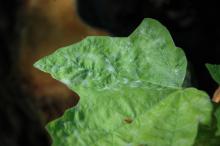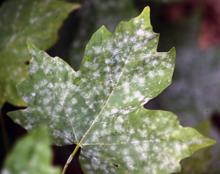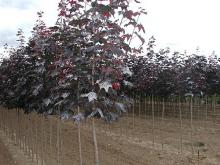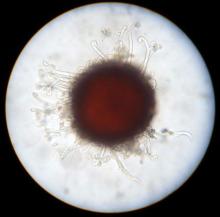Cause Phyllactinia marissallii, a fungus that attacks only maple. Sawadaea bicornis has been found in all states on bigleaf and Norway maple. It is suspected that this fungus was introduced into North American sometime before 1938 from Europe. S. tulansnei has been found in Idaho and Oregon on Norway maple. A species in the genus Sawadaea has been found in lower mainland British Columbia (on big leaf maple). In Idaho, powdery mildew seems to be restricted to Acer platanoides in northern Idaho while the native Rocky Mountain maple populations are not mildewed.
Conidia are readily wind disseminated. Chasmothecia develop within the external hyphae and form appendages late in their development. The uneven wall thickness and bulbous nature of the appendages allows the entire cleistocarp to be dislodged from the host. When dry, the appendages flex like a spider's legs and allow the cleistocarp to be dislodged and carried by wind. These fungi may overwinter as chasmothecia or through buds infected the previous season.
Symptoms A white fungal growth often occurs with small black fruiting bodies (chasmothecia), on the undersides of mature leaves. Phyllactinia sp. typically have very sparsely growing mycelia and colonies can be difficult to detect while Sawadaea sp. have more obvious robust colonies. S. tulansnei was described as having white mycelium present in irregular, discrete, scattered spots or almost continuously on the upper surfaces of leaves and also was present on some petioles.
Chemical control Most of these fungicides are not labeled for use on trees to be used for syrup production. Fungicides will do best when used before symptoms develop. Few materials have good eradicant activity. Use at 7- to 14-day intervals; using shorter intervals when environmental conditions favor disease development. Alternate or tank-mix products from different groups that have different modes of action. Limit the use of any one group during crop production.
- Armada 50 WDG at 3 to 9 oz/100 gal water. Do not use a silicone-based surfactant. Not for nursery or greenhouse use. Group 3 + 11 fungicide. 12-hr reentry.
- Avelyo at 3 to 5 fl oz/100 gal water. Group 3 fungicide. 12-hr reentry.
- Banner MAXX at 5 to 8 fl oz/100 gal water may be effective. Group 3 fungicide. 12-hr reentry.
- Eagle 20 EW at 6 to 12 fl oz/100 gal water. Do not use treated trees to produce syrup. Group 3 fungicide. 24-hr reentry.
- Heritage at 1 to 4 oz/100 gal water plus a non-silicone-based wetter sticker. Group 11 fungicide. 4-hr reentry.
- Insignia at SC 3 to 6 fl oz/100 gal water. Do not use with organosilicate-based adjuvants. Use preventively only. Listed for Amur, Japanese, Norway, Sugar, Soft and Negundo maple. Group 11 fungicide. 12-hr reentry.
- Magus at 12 to 24 fl oz/A for plants grown in a greenhouse or shade house. Only one application allowed. Bees are very sensitive. Group 21 acaricide. 12-hr reentry.
- Myclobutanil 20 EW T&O at 6 to 12 fl oz/100 gal water plus spreading agent. May observe a PGR effect. Group 3 fungicide. 24-hr reentry.
- Orkestra at 6 to 8 fl oz/100 gal water. Group 7 + 11 fungicide. 12-hr reentry.
- Safer Brand Garden Fungicide (Ready To Use 0.4% sulfur) thoroughly sprayed over the entire plant. Do not use when the temperature is over 85°F or within a few weeks of an oil spray. H
- Seido at 4 to 5 fl oz/100 gal water plus an adjuvant. Group 50 fungicide. 4-hr reentry.
- Spectracide Immunox Multi-Purpose Fungicide Spray Concentrate for Gardens at 1 fl oz/gal water. Group 3 fungicide. H
- Tourney EZ at 1 to 4 oz/100 gal water. Group 3 fungicide. 12-hr reentry.
- Trinity at 4 to 12 fl oz/100 gal water. Group 3 fungicide. 12-hr reentry.
Biological control
- Cease or Rhapsody (Bacillus subtilis strain QST 713) at 2 to 8 quarts/100 gal water is registered for Japanese Maple. Active ingredient is a small protein. Efficacy in the Pacific Northwest is unknown. 4-hr reentry. O
References Bradshaw, M., Braun, U., Elliott, M., Kruse, J., Liu, S. Y., Guan, G. and Tobin, P. 2021. A global genetic analysis of herbarium specimens reveals the invasion dynamics of an introduced plant pathogen. Fungal Biology, 125:585-595.
Stanosz, G., and Smith, D. 2014. Sawadaea tulasnei Powdery Mildew of Norway Maple (Acer platanoides) in Oregon. Plant Disease. 98:281. (Abst)





